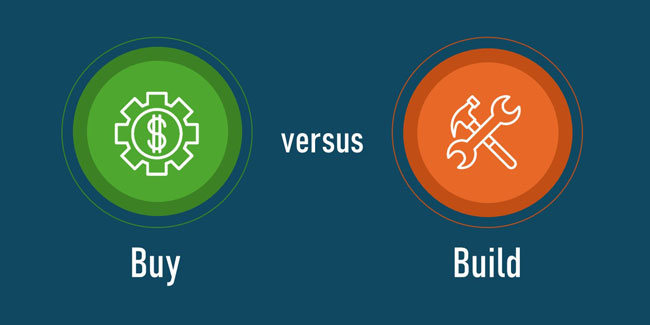Among the more complex technology solutions related decisions a company makes is the choice of build vs buy. Typically, larger companies with strong IT staff gravitate towards a build decision while smaller companies usually go for a buy decision as IT is not their core focus. And there are a large number of companies in the middle of the spectrum that can go either way. This build-vs-buy decision is also valid for large companies too depending on the nature of software solutions they are seeking.
While the thought of building a solution in-house seems like a good idea, various factors should be considered before making a choice. Considerations include the IT team’s experience, domain expertise, available bandwidth, costs, implementation timeline, and ongoing support capabilities.
Getting answers to the following questions will help begin the evaluation process:
-
Does our IT Team have the domain expertise to build this new solution?
-
Do we have the required IT manpower to commit to building and implementing a solution?
-
What would be the required budget and the expected timeline for implementation?
-
Should we spend hours having our best people design and architect a solution, or buy one that already exists and is proven in the market?
-
Will we have the resources and expertise to enhance or even maintain the solution to meet our evolving business needs once the solution is deployed?
In addition to the above, technical factors need to be considered before deciding to buy or build a solution:
-
Configuration - Having software that is configurable instead of hard coded reduces development time and costs while providing flexibility for users when managing changing business needs.
-
Useability - Choosing an intuitive, user-friendly solution accelerates adoption and user satisfaction.
-
Security - Creating and maintaining a secure solution that will be used by internal and external users for years to come can become expensive to maintain, requiring monitoring and continuous investments in licenses for new and better security tools.
-
Data Integration - Data feed maintenance will require dedicated IT data resources who could have limited capacity as they will be supporting the data needs of all the organization’s business applications. Maintaining data feeds requires dedicated IT data resources, potentially limiting capacity for supporting the data needs of the entire organization.
While there are situations that warrant a build strategy, such as creating a proprietary software to maintain or create a distinct business advantage or fulfilling an exact need unique to a company, most often a buy strategy from a proven solution provider will be a better choice in both the short and long term.
Since 2009, Optimum Info has been developing and continuously improving our integrated Network Development and After-Sales suites of business software solutions. We are committed to supporting the unique business needs of the Automotive, Powersports, Transportation, and Equipment Industries we serve.














